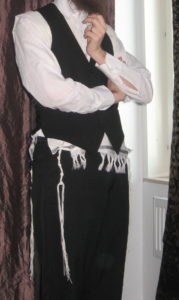Let’s finish up our study of Numbers Chapter 15 by concluding with a review of what we learned about TZITZIT, the memory device that was to serve as a visible reminder to every Israelite that God is dead serious about His Laws and that the consequences for disobeying His Laws can be quite severe.
Remember, in Scripture, the giving of the command to wear TZITZIT followed immediately after a man was sentenced to death for gathering wood to start a fire on the Sabbath.
The primary takeaway from this chilling event is that disobedience to HASHEM’s commandments brings death, period.
Let’s get started with our review.
YOU LEARNED THAT…most English translations of the Bible will call TZITZIT the “fringe“, “tassels“, or “hems” of one’s garment.
YOU LEARNED THAT...TZITZIT are made out of white linen threads wrapped around a single purple woolen strand and then attached to the corners of one’s garment. The purple color was taken from a tiny sea creature called the Murex snail. In Hebrew, the purple thread of the TZITZIT is called TEKHELET.
YOU LEARNED THAT…the TZITZIT did not carry any supernatural power. It was NOT a magic talisman akin to how pagan Christians use crosses to ward off evil spirits. The purpose of the TZITZIT was to play upon the most powerful of all the human senses, one’s visual faculties, to achieve the goal of reminding Israel to obey God’s commands lest they suffer punishment, sometimes severe punishment like the man who was executed for gathering wood on Shabbat. In addition, the TZITZIT had no place in religious ritual. It was a simply a memory device.
YOU LEARNED THAT…the TZITZIT were a physical sign of holiness. To be more specific, the TZITZIT were a sign of nobility and reflected a degree of priestly service that every Israelite was honored to have (and obligated to keep). One of the keys to understanding TZITZIT is they were the one exception to the prohibition against common Israelites wearing garments woven out of two different kinds of materials. The Torah states that one can wear all wool or they can wear all linen, but the two could not be mixed.
YOU LEARNED THAT…women could also wear TZITZIT. Although the Torah does not specifically address the issue of women in this matter, it was considered optional and permitted for women to attach TZITZIT to their clothing.
YOU LEARNED THAT…the Hebrew word for the mixing of materials is SHA’ATNEZ. Since the tribe of Levi had been separated away from Israel for the purpose of being God’s special servants and priests, the High Priest and the common priests wore a couple of items of clothing that were SHA’ATNEZ.
YOU LEARNED THAT…the ONLY item woven out of mixed materials that a common Israelite could wear were the TZITZIT. The TZIZIT was also the only item woven out of mixed materials that was allowed to be worn outside the camp of the Tabernacle grounds. The reason is because the mixing of two materials (linen and wool in this case) renders an object Holy and the use of a holy item is restricted to the confines of the Temple grounds (or in Moses’ day, the camp boundaries surrounding the Wilderness Tabernacle). If a holy item was taken outside of the boundaries of the camp of Israel, it would become defiled and this could result in severe consequences. Interestingly, the reverse is also true. If a common item was offered to God, it could become HOLY. But the Lord would never allow this happen since He so carefully guards His Holiness.
And that’s all folks!
NEXT TIME WE BEGIN NUMBERS CHAPTER 16




Leave a Reply